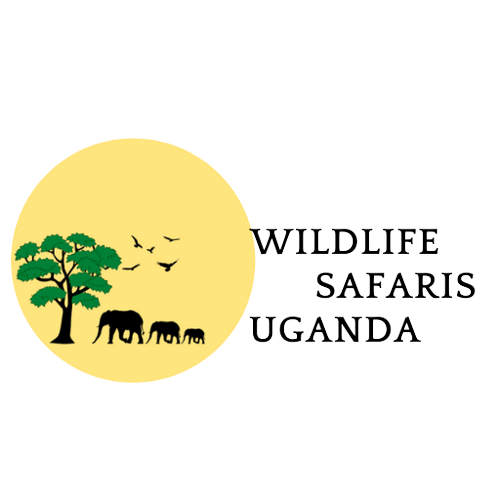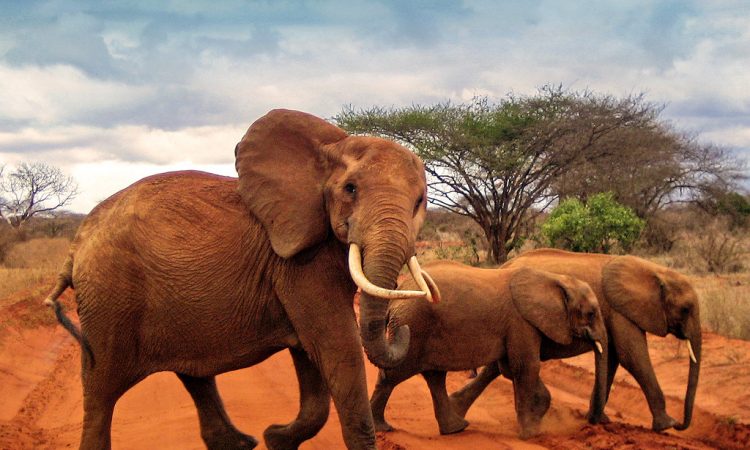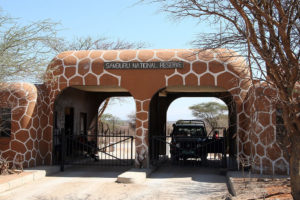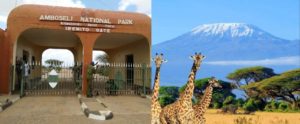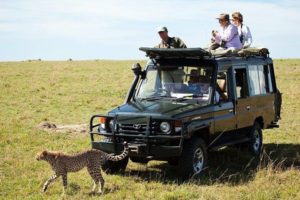Tsavo national park is made up of two separate parks that is Tsavo East National Park and Tsavo West National Park, located in the Coast Province of Kenya in between Nairobi city and Mombasa. Tsavo National Park is nearly 22,000km2, being the largest national park safari in Kenya and one of the largest in the world. The park was split into two due to the railway going from Mombasa to the interior of Kenya. Tsavo National Park is one of the main tourist safari destination in Kenya that is located in the southwestern part of Kenya, the park is known for having quite number of lions that were sometimes termed as the’’Man-Eaters’’ and other animal species like the large herds of elephants, the park measures 13, 747 square kilometers.
Tsavo East National Park.
Tsavo East National Park is one of the oldest and largest national park in Kenya, located south East of Kenya near the Town of Voi in the Taita-Taveta District of Coast Province, inland from the coast, it is 13,747 square kilometers, situated in a semi-arid area previously known as the Taru desert, it was opened in April 1948. The park is divided into east and west sections by the A109 road and a railway. Named for the Tsavo River, which flows west to east through the national parks, it borders the Chyulu Hills National Park and the Mkomazi Game Reserve in Tanzania.
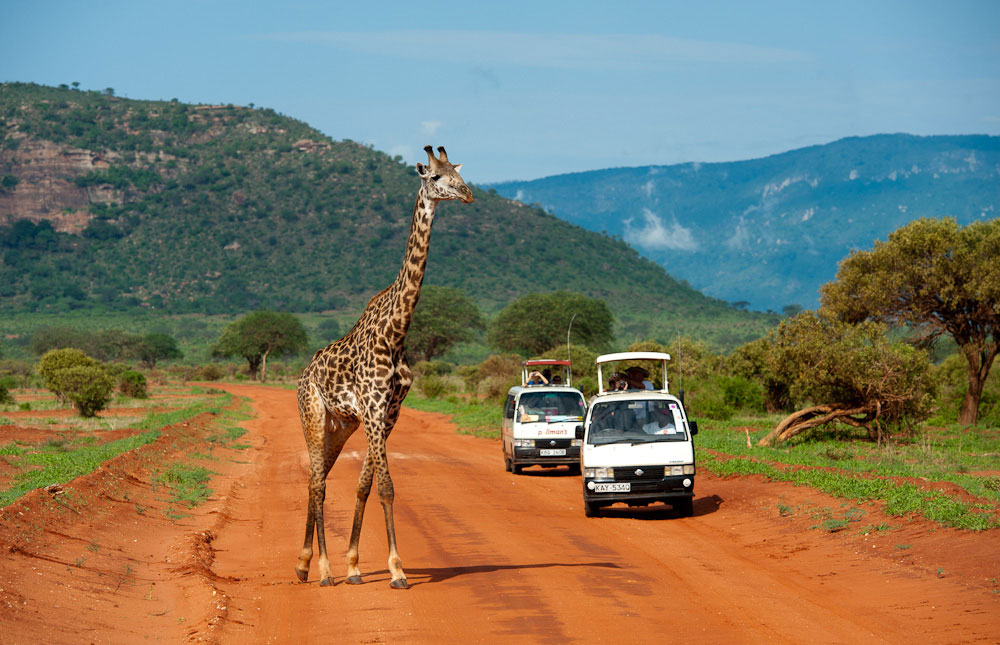
Attractions in Tsavo East National Park.
Wildlife.
Tsavo East national Park is a best wildlife safari destination in Kenya, as in the park hosts 675 wildlife individuals with a huge number of lions, the park as well as has mammals and primates that includes the Big 5 mammals, other mammals in the park includes the elephants, leopards, cheetah, buffalos, black rhinos, impala, aardwolf, grevy’s and plain zebras, warthogs ,civet, dik-dik, caracal, African wildcat, eland, African hunting dog tree hyrax, black-backed and side stripped and spotted hyena, lesser kudu, gazelles, small spotted genet, greater galago African hare, marsh mongoose, bush duiker, red duiker and many more. Primates in Tsavo east national park includes; yellow baboon, Skye’s monkey and many more.
Bird species.
Tsavo East national park has got over 500 bird species, as it has many-dry specials which are easy to spot, including magnificent golden-breasted starling, golden pipit and vulturine Guinea fowl. The park is also the southernmost stronghold for the Somali ostrich. The park’s huge area is a significant wintering ground for migrant species from Europe and migrant birds are present from November to April. Bird species in Tsavo East national park includes African finfoot, Fischer’s starling, Martial eagle, Northern brownbul, Pangani longclaw, Red-bellied parrot, Rufous chatter, Somali bee-eater, Vulturine guineafowl, Taita falcon, Taita fiscal, Somali bunting and many more.
Kanderi swamp.
Kanderi swamp is one of the water sources of the ecosystem of Tsavo East national park and it is one of the spectacular tourists attractions in the park, the swamp lies along the Voi River and as fresh water source the river attracts a huge number of animals. Kanderi swamp is a great site for Kenya Wildlife viewings safari and during a game drive you get to enjoy viewing many animals’ species like elephant’s buffalos, antelopes and many more.
Aruba dam.
Aruba dam is located east of the Voi gate a water reservoir in Tsavo east national park built in 1952 along Voi River, the dam is one of the excellent Kenya wildlife viewing spots in Tsavo national park, the dam attracts thousands of animals of Tsavo East national park most especially in the dry season, these animals crowd the dam so as to drink water, also some birds live around the dam, some of the animals that can be spotted includes the duikers, elephants, waterbucks, warthogs, leopards, rhinos, giraffes, buffalos and many more.
Galana River.
Galana River gathers a variety of wildlife species which is among the main attractions in Tsavo East National Park, the source of this river is the highlands in the south eastern part of Kenya and it flows through the national park and into the Indian Ocean, during a safari to the Galana River, tourists can also see crocodiles as they explore the entire beauty of the park.
Tsavo River.
Tsavo River is another attraction in Tsavo East national Park which can be seen at this safari destination and it runs through, the river connects with Athi River to form Galana River.
Mudanda rock.
Mudanda rock is located near the Manyani gate in Tsavo East National Park, during the dry season, wildlife species gather around water catchment area near the stratifies rock which makes it easy for the tourists to see the various wildlife species during their safari as they spot the wildlife from the pool.
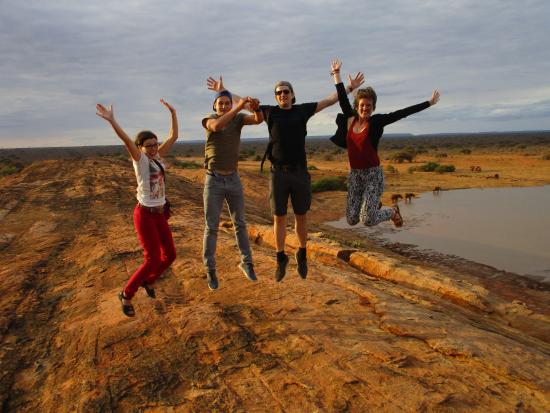
Yatta plateau.
Yatta plateau is one of the fascinating attractions in Tsavo East national park and must visit feature while on a Kenya safari in the park, Yatta plateau is the world’s longest lava flow of 290 kilometers formed as a result of lava that formed the Ol Doinyo Sabuj Mountain during the eruption process. Yatta plateau runs along the western border of Tsavo East national park above Athi River. Yatta plateau is the longest lava flow in the world, the plateau was formed by lava from the Ol Doinyo Sabuk Mountain during its eruption process, the plateau is characterize by the plain wide valleys as well as shallow spaced alleys which were formed as a result of lava flows.
Lugard falls.
Tourists can also visit the Lugard falls during their safari to Tsavo East National Park and is main attraction formed along the Galana River, this attraction is characterized by rock patterns of cooled lava. The Lugard falls were named after Lord Fredrick Lugard as he made his way through the region. The rapids were formed as a result of interruption of the river flow by sculpted channels and rocks. At the bottom of the falls, tourists can see wildlife species buffaloes and hippos as we as crocodiles in the pool formed at the bottom of the falls.
Activities done in Tsavo East national park.
Bird watching.
With over 500 bird species, Tsavo East national park offers a truly distinctive and unbelievable birding safari experience, as these include many of the dry-country specials easily spotted such as the Vulturine Guineafowl, Ortolan Bunting, Bat-like Spinetail, Yellow throated Sandgrouse, Golden-breasted starling and many more.
Wildlife viewing.
Tsavo East national park offers wildlife viewing with all the members of the African big five such as the Lion, Buffalo, Elephant, rhino and Leopard and large schools of hippos and gigantic Nile crocodiles including other smaller species of mammals like dik-dik, bush baby and Klipspringers are supported by the park and offer one of the most spectacular wildlife viewings.
Cultural tours.
Tsavo East national park is one of the best destinations with regard to cultural tours, most of the national parks are bordered by the local Maasai people who have unique cultures which has been diluted with the current modernization, cultural tours in Tsavo are some of the activities and experience guests can enjoy as the guests enjoy their home settlement patterns which are gazetted and well fenced with local materials like thorns, as well as their dances, plays, songs and many more.
Guided nature walks.
Guided nature walks sometimes known as the walking safaris are some of the top activities of Tsavo national park. The guided nature walks are done under the park ranger who is armed to protect the guests from any danger at the park.
Best time to visit Tsavo East national park.
The best time to visit Tsavo East national park is in June to October and January to February, when the conditions in the park are favorable for wildlife watching. During the peak of the short rains (November) and the long rains (April and May) conditions can be more challenging.
Where to stay in Tsavo East national park.
Tsavo East national park provides the most comfort accommodations for the guests during their visit in the park that includes the Budget, Mid-range, and Luxury that includes Kilaguni Serena safari lodge, Tsavo Lodge Voi, Voi Wildlife Lodge and many more.
How to get to Tsavo East national park.
Tsavo East national park can be accessed into two ways by air, train and road transport from Nairobi to the park.
By Road transport.
Tsavo East is in southeast Kenya, 325km/201mi from Nairobi and 250km/155mi from Mombasa, Nairobi or another park depending on your internary which takes around 7hr 8minutes.
By Air transport.
There are no scheduled flights to Tsavo East national park, but there are several airstrips available for the charter flights.
By Train transport.
The best way to get from Nairobi to Tsavo East national park without a car is to use a train and travel which takes 4hr 29 min and costs
Tsavo West National Park.
Tsavo West national park is located in the coast province of Kenya. The park covers an area of 9,065 square kilometers, the park was opened in April 1948. The A109 road Nairobi-Mombasa and a railway divides if from the adjoining Tsavo East National Park. Together with adjoining ranches and protected area. Tsavo West is a more popular destination safari on account of its magnificent scenery, Mzima Springs, rich varied wildlife, good road system, rhino reserve, rock climbing potential and guided walks along the Tsavo River. Tsavo National Park is managed and operated by the Kenya Wildlife Service.
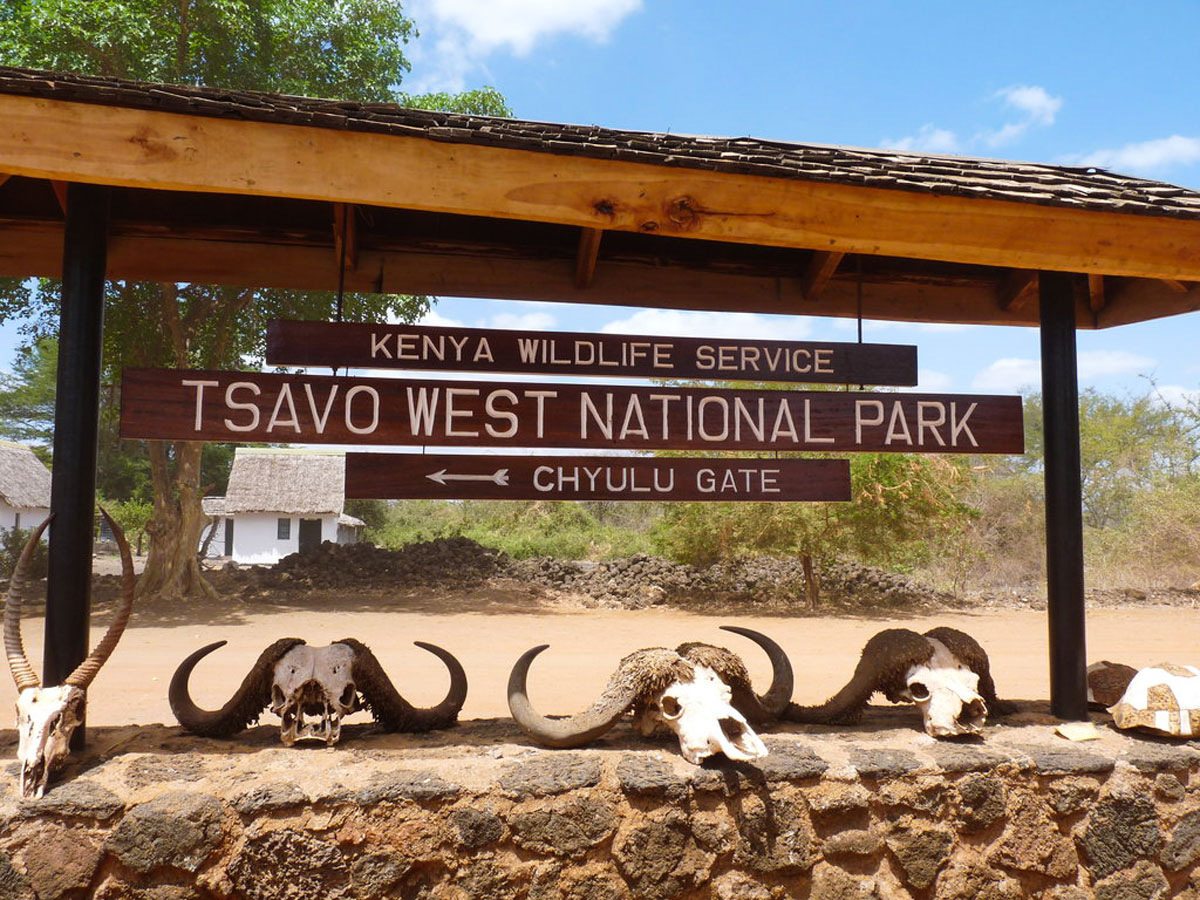
Attractions in Tsavo West national park.
Mzima Springs.
Tourists who visit Tsavo West National Park can also visit the Mzima springs which are known to have clear water and hippos, crocodiles, the springs consist of four springs in the western part of the park. Mzima springs get its water from a natural reservoir under the Chyulu hills, the springs are source of water for the wildlife species which graze around the savanna plains, the trees around the springs are homes to the vervet monkeys which feed on the fruits from the date trees, raffia palms, waterberrys and figs, also various bird species can also be seen in the trees around the Mzima springs.
Wildlife.
Tsavo West National park is a home of different animal species that includes all the African Big 5 mammals like the lions, leopards, buffaloes, elephants, Rhinos. The nearby ranches habit both Black and Rhinos, the animal species at the park are permanent residents hence making game drives to be more rewarding any time of the year, the animal species that can be found in the park includes zebras, cheetahs, topis, kudu, jackals, impala, African wild dogs and many others.
Bird species.
Tsavo West National Park is a birding paradise with over 400 bird species that are distributed across different vegetation cover at the park, The different habitants in the park has created to this large species of birds that range from water to forest birds such as the red-Backed shrike, Northern Brownbul, Eastern black-headed oriole, starlings, African finfoot, Golden pipit and many more.
Poacher’s hill.
Poacher’s hill is a magnificent feature to visit on your safari in Tsavo West national park, poacher’s outlook offers 360 degrees panoramic views of the grand Tsavo West national park, originally the hill was used by the poacher’s to look out for elephants and rhinos before gazetting of the area. Mzima springs is one of Tsavo’s most popular wildlife attractions owing to its resident populations of the hippos and the Nile crocodiles.
Shetani Lava Flow.
Shetani Lava Flow is also the major attraction, this is the black folded lava which flows across the savannah as well as the awesome views in the surrounding, different wildlife species can also be seen during a safari to the Shetani lava flows and these include predators which can be seen wandering around. Shetani caves that were formed as a result of volcanic activity are also found near the lava flows. Shetani means devil which according to the locals describes the time when lava was flowing the ground the locals believed that it was the devil himself coming out from the ground, the Shetani lava flow can be accessed from one of the entrance gates into the Tsavo West national Park which is the Chyulu gate.
Ngulia rhino sanctuary.
Ngulia rhino sanctuary is a stronghold and bleeding place for endangered rhinos in Tsavo and Kenya as a nation, Kenya as a tourist destination safari and a home of wildlife used to be a habitat to over 8000 black rhino individuals by 1970’s but due to human practices like poaching and encroaching the rhino’s habitants. Ngulia Rhino sanctuary has over 80 rhino individuals which are easy to spot while on your visit in the sanctuary as you can as well spot the black rhinos but you can also spot leopards and elephants, though the black rhinos which are kept at the sanctuary are nocturnal species and this means that it is rare to see them however not impossible to see the rhino species, due to danger of extinction of the black rhinos the sanctuary is well fenced and guarded by the rangers and the staff boosts the rhino populations as well as other animal species like the elephants in the park.
Chaimu hill.
Chaimu hill has a great observation point while enjoying the views of Tsavo West national park and the views of Majestic Mountain Kilimanjaro from a distance, this hill is great for hiking safari which takes approximately 20 minutes of hike.
Roaring rocks.
Roaring rocks are spectacular feature in Tsavo West national park resembling the same spot in lion king where mufasa holds Simba showing the young to the animals he led as a king, these rocks are situated near Ngulia rhino sanctuary and for a long time these rocks have been an observation point.
Chyulu Hills.
Chyulu Hills are an impressive features that you should visit during your safari in Tsavo West national park, the hills are situated 150 kilometers east of Kenya rift and 30 kilometers from Kibwezi town. Chyulu hills form a 100 kilometers long volcanic field covering an area of 741 square kilometers with the highest peak standing at the highest of 2188 kilometers, the hills create a magnificent scenic view which is perfect for sightseeing and photography.
Lake Jipe.
Lake Jipe is found in Tsavo West national park, lying across the Kenyan/Tanzanian border, a beautiful Lake that was once the unique jewel of Tsavo West, being the only natural lake in the vast 8,000 square mile arid scrubland that comprises Kenya’s famous Tsavo National Park
Activities done in Tsavo West national park.
Bird watching.
Tsavo West national park is a birding destination in Kenya with over 400 bird species that are distributed across different vegetation covers at the park, Ngulia Hills, being one of the landmarks in the park, is situated along one of the world’s busiest avian migration routes, Bird ringers make an annual pilgrimage here between October and January. Ngulai is the site of Africa’s foremost bird-ringing (tagging to enable individual bird identification) project. More than 100 migrant and resident species have been ringed here, the most prolific being marsh warbler, river warbler, red-backed shrike, thrush nightingale and common whitethroat and many more, Mzima springs are good birding location in the park.
Cave exploration.
The Shetani caves, located next to the Shetani lava flows, were formed as a result of the volcanic activity, the guests can visit these caves to learn about their attached history. While at the caves, there is a high possibility of seeing hyenas and other small mammals. Exploring the cave requires one to carry a torch for lighting since it gets dark when in there.
Rock climbing.
Tsavo West national park offers some of the best rock climbing adventures in Kenya safaris, as the most impressive rock climb is the famous 300m Kichwa Tembo rock which attracted the first adventure and later, the second expedition to conquer the impressive Tsavo Chimney, other hiking safari and rock climbing areas includes the Ngulia Hills, Mastodon and ivory tower as they have viewpoints that allows you to have a panoramic view of the landscapes, large herds of elephants roaming the vast plains and flocks of birds in the park.
Game Viewing.
Game viewing in Tsavo West national park offers true African wildlife experience with more chances to see all African big five. The game drives are done three times a day that is morning game drive, afternoon and night game drives. As the elephants can be seen in large numbers.
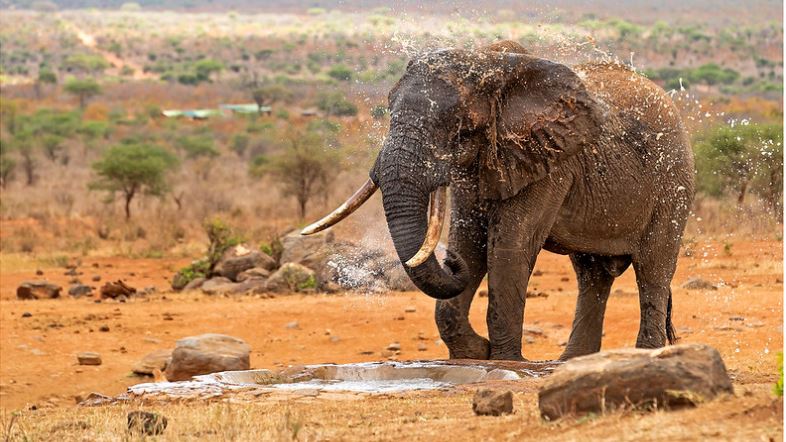
Best time to visit Tsavo West national park.
The best time to visit Tsavo West national park is during the dry season from the month of June to October and January to February. Although the park can be visited any time of year, wildlife viewing during the height of the wet season (November, April and May) is not recommended.
Where to stay in Tsavo West national park.
Tsavo West national park offers a variety of the accommodation options for the guests which are well comfortable and suitable that includes that are categorized into Budget, Mid-range and Luxury such as Kilagui Serena safari lodge, Severin Safari camp, Ngulia safari lodge, Rhino Valley lodge, Voyager Ziwani camp, salt lick safari lodge, Man -eaters’ camp, Lake Jipe safari camp and many more.
How to get Tsavo West national park.
Tsavo west national park can be got into two ways that is road and air transport from Nairobi.
By Road transport.
The park is about 230km away from Nairobi and about 250km from Mombasa. From Lake Nakuru National park, it is about 450km.
By Air transport.
These are scheduled flights from Nairobi to Tsavo West national park. These flights originate from Jomo Kenyatta International Airport or Moi international Airport for visitors from Mombasa. Tsavo national park has got airstrips for chartered flights.
